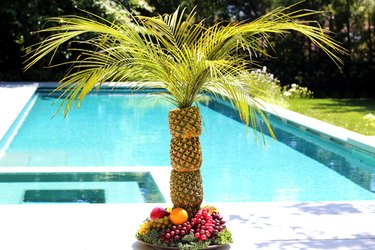
Here's a creative idea for a combination centerpiece/serving tray that puts the "wow" in your next luau or tropical-themed party. The palm tree is made of pineapples stacked on top of each other with palm fronds coming out of the top. The secret to keeping the pineapples upright is PVC pipe—but you can tell everyone it's made with island magic.
Video of the Day
Things You'll Need
4 to 5 pineapples
Palm fronds
PVC pipe, 1 inch by 24 inches
PVC table cap, 1 inch
Wood screws
12-inch wood disk, 3/4 inches thick
Wooden skewers
Aluminum foil
Knife
Serving platter
PVC pipe cutter (optional)
How to Make a Pineapple Palm Tree
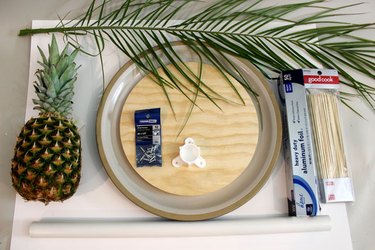
1. Screw PVC Table Cap to the Wood Base


While the secret to keeping the pineapples standing is a PVC pipe, what allows the PVC pipe to stand vertically is a PVC table cap. You can find PVC table caps in different sizes at home improvement stores or online. Screw the table cap into the center of a 12-inch wood disk, which you can find pre-cut for you at most home improvement stores.
2. Cut the PVC Pipe
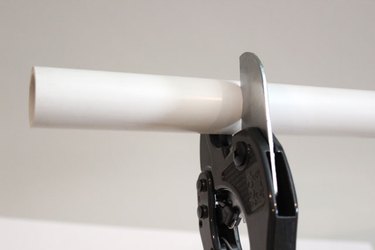
The 1-inch PVC pipe comes in a pre-cut 24-inch length. Measure the height of your pineapples to determine if, when stacked, they will be higher than the PVC pipe. Ideally, the stacked pineapples should extend just over the top of the PVC pipe to completely hide it when the project is finished.
Tip
If your pineapples are shorter than 24 inches when stacked on top of one another, you'll need to cut the PVC pipe. If you don't want to cut the pipe, add an extra pineapple on top to hide the excess.
3. Insert the PVC Pipe in the PVC Table Cap

Wash your PVC pipe in hot, soapy water. Then place the PVC pipe in the table cap so that it fits snugly.
4. Cover With Aluminum Foil

Cover the entire PVC pipe and wood base with aluminum foil. The foil will be a barrier to keep the pineapple and other food on the serving tray from coming into contact with the pipe and wood. Not only does the foil help with food safety, but but it also makes cleanup easier.
5. Slice the Tops and Bottoms of the Pineapples

Using a sharp knife, cut the top and bottom off of each pineapple, removing the stem completely. Try to cut straight across so that the cuts are parallel and level.
6. Core the Pineapples
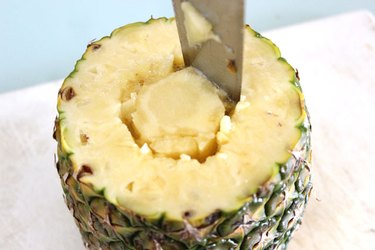
Cut out the center part of the pineapple, making the hole just over 1 inch in diameter. Be careful with the knife. When you've cut all the way through, the core can be pushed out. If there is any edible fruit around the core, slice it off and save it before discarding the core.
Tip
If you have a pineapple corer, use that for this step. It will be much safer (and easier) to work with.
7. Place the Base on a Serving Platter
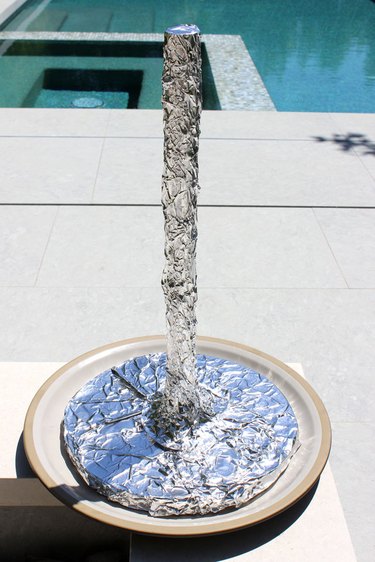
Once you have built the pineapple palm tree, it will be heavy, awkward, and difficult to move around. Ideally, you should assemble your pineapple palm tree at your party location and on top of the serving platter you ultimately want it to rest on. Place the foil-covered base on a large serving platter, and then you're ready to add the pineapples.
8. Insert the First Pineapple

Line up the hole in the pineapple with the PVC pipe and slide the pineapple down until it sits on the base. Now you can see why we covered the top of the pipe with foil—so pieces of pineapple don't fall in the opening of the PVC pipe when the fruit goes through the pipe.
9. Stack the Next Pineapple

Insert three wooden skewers in the first pineapple, and then slide down the second pineapple on top of the first, connecting them with the three skewers. While the PVC pipe keeps the pineapples upright, the skewers keep them from moving side to side.
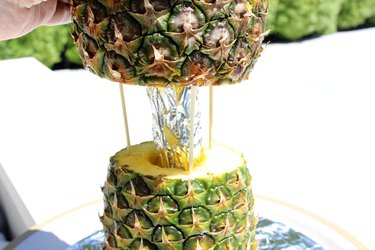
10. Continue Stacking the Pineapples

Place skewers in the second pineapple and slide the third pineapple down onto it. Repeat this process for the fourth pineapple and the fifth, if applicable, until the PVC pipe is hidden by the pineapples. You now have the tree trunk.
Tip
Despite your efforts to try to cut the pineapples straight across, they still may look angled when assembled. Don't worry—the palm tree looks more realistic when there's a slight tilt.
11. Insert the Palm Fronds

Now that the pineapples are in place, puncture a hole in the foil at the top of the PVC pipe. Insert palm fronds into the opening of the PVC pipe from different angles. By using the PVC pipe as the frond holder, it keeps them from coming in contact with the fruit. It's still a good idea to wash the palm fronds before inserting them into the pipe.
12. Cover the Base

Now that the palm tree is complete, you can display food on the serving platter by placing it directly on the foil-covered base or on a bed of kale. The kale helps hide the base, but depending on what you are serving, it may not be necessary.
The Finished Pineapple Palm Tree

The pineapple palm tree will definitely be the talk of your next tropical-themed gathering. After your party, the trunk can be disassembled easily and the pineapple cut up and eaten. Cleanup is a breeze; just remove the aluminum foil and rinse the PVC pipe and wood base, if necessary. And because the pipe comes off the table cap, the base is easy to store.